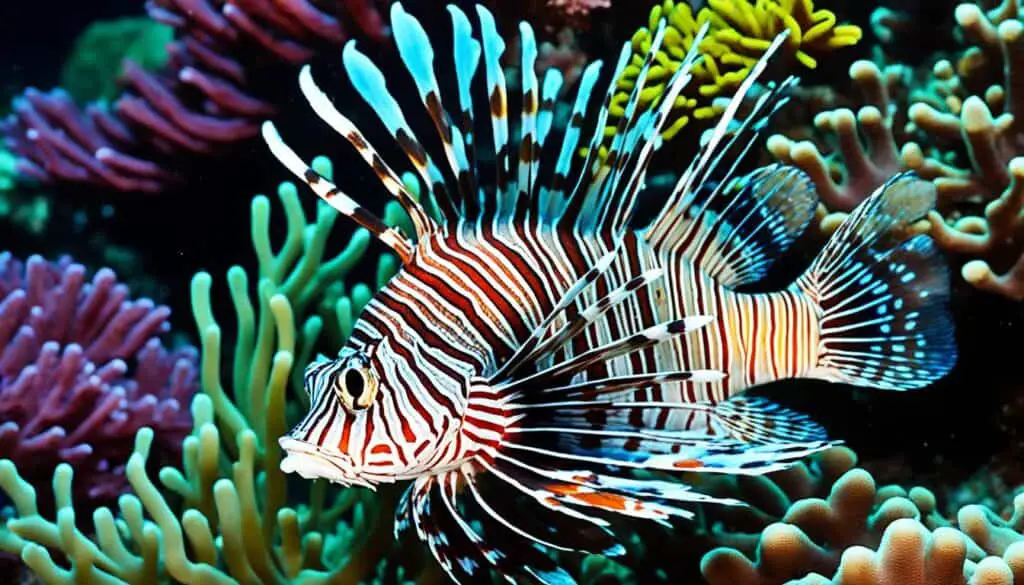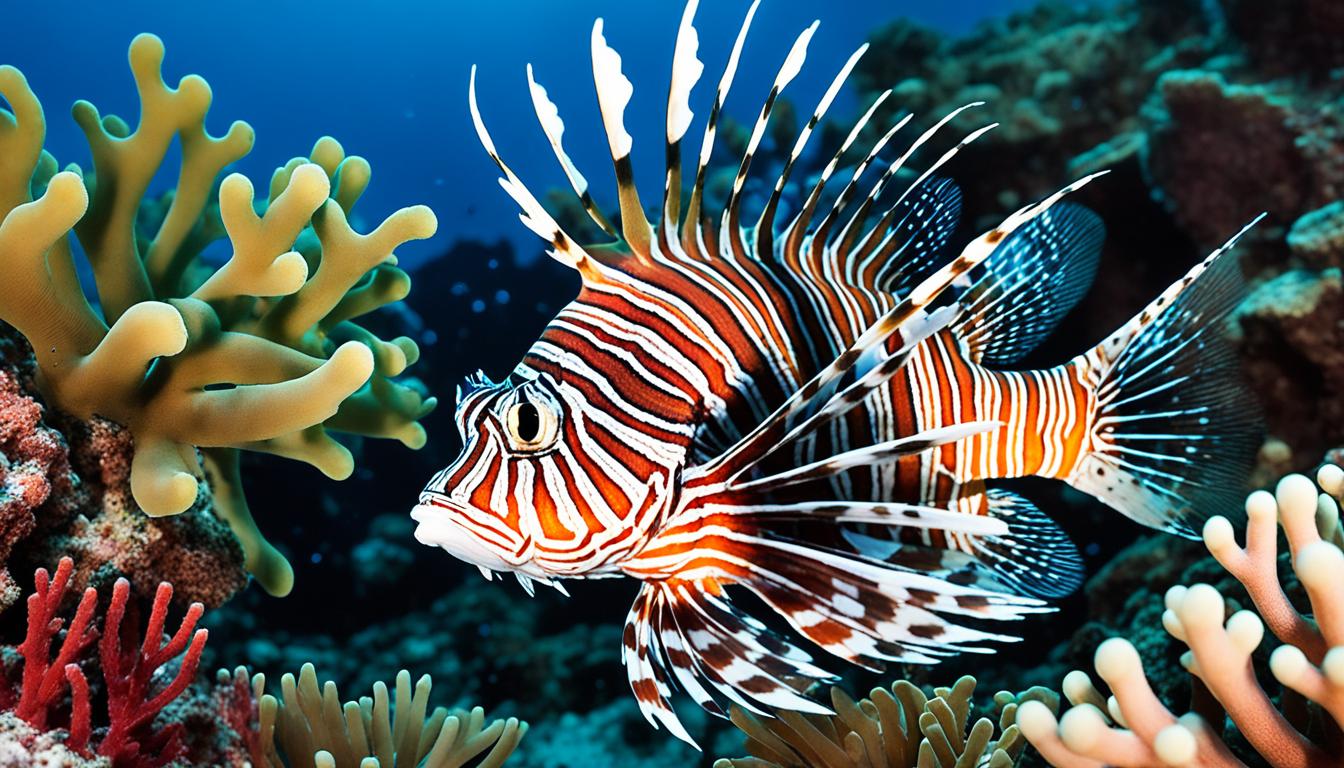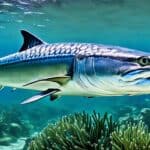Lionfish are amazing sea creatures with special adaptations that help them live in different places. They have venomous spines for protection and can reproduce quickly. These traits let them take over places like coral reefs and rocky spots, showing how they adapt to their homes.
They also look very striking, which helps them in many ways. Their looks are key to their survival. This starts our journey into the world of lionfish and their amazing ways of adjusting to the sea.
Understanding Lionfish Adaptation
Lionfish have amazing lionfish adaptation features that let them live in many marine places. They live in the warm waters of the Red Sea and the Indian Ocean. These fish show how well they can adapt to different environments, which helps them survive.
Knowing how lionfish are able to thrive is key to understanding their role in their habitats. They have few natural enemies, so they can move around freely in their ecosystem. Their special features, like venomous spines, keep predators away and help them catch prey.
Lionfish also have behaviors that help them survive. They hunt quietly, waiting for prey to come close. This way of hunting, along with their physical traits, makes them top predators.
In short, the lionfish environmental resilience and their lionfish adaptation features show they are a key species in marine ecosystems. They have a unique ability to face challenges in their environment.
The Role of Coloration in Habitat Adaptation
The vibrant lionfish coloration helps them survive in different places. Their colors, like red, white, and black, help them live well as both hunters and protectors. They use these colors to adapt to their lionfish habitat.
Camouflage for Prey Capture
Lionfish hide among coral or rocks using their colors. This makes them hard to see, giving them an edge when catching prey. They sneak up on smaller fish and crustaceans, making hunting more effective.
Warning Coloration for Predator Defense
The lionfish’s colors also warn off bigger fish that might want to eat them. Their bright colors show they are poisonous, thanks to their venomous spines. This helps them stay safe and keep their hunting skills sharp.
How do lionfish adapt to their environment?
Lionfish show amazing flexibility in adapting to different marine conditions. They can live in a wide range of temperatures, which helps them succeed in many places. This part will look into how lionfish adapt to their environment and where they live.
Ability to Thrive in Varied Temperature Ranges
Lionfish can live in temperatures from 60°F to 90°F. This wide temperature range lets them live in both warm and temperate waters. They can handle changes in temperature, which helps them survive and thrive in different places.
Occupying a Wide Range of Marine Habitats
Lionfish can be found in many types of marine habitats, including:
- Coral reefs
- Seagrass beds
- Rocky substrates
- Deep waters
- Shallow coastal areas
This variety of habitats is important for finding food and places to breed. Lionfish are good at living in different places. They use clever hunting tactics in these various habitats, showing how well they adapt.
Lionfish Behavior in Different Habitats
Lionfish show interesting behaviors in various places. These behaviors help us understand how they survive and affect their environment. They change their hunting and social ways based on where they live.
Nocturnal Ambush Feeding Techniques
Lionfish hunt at night, using ambush tactics. They stay still until prey is close. This way, they catch smaller fish and crustaceans more easily.
They surprise their prey, making hunting successful. This clever hunting helps them get food from their surroundings.
Solitary Nature and Breeding Strategies
Lionfish are usually alone, coming together only to breed. A male lionfish may mate with many females. This leads to thousands of eggs, affecting their breeding.
Many young lionfish don’t make it, but this helps their numbers grow fast. This shows how they can thrive in different places.

| Behavior | Characteristics | Habitat Impact |
|---|---|---|
| Nocturnal Ambush Feeding | Stealthy and patient hunting style | Effective in coral reefs and rocky areas |
| Solitary Nature | Prefers individualism except during mating | Reduces competition for resources |
| Lionfish Breeding | Mates with multiple partners, high egg production | Contributes to rapid population increases |
Lionfish Environmental Resilience and Survival Strategies
Lionfish show amazing ability to survive in tough environments. They adapt well to few predators and reproduce quickly. This helps them live in many marine places, changing local ecosystems.
Adaptation to Limited Predator Threats
In places like the Atlantic Ocean, lionfish don’t face many natural enemies. This low threat lets them grow and spread easily. So, their numbers can increase quickly, which worries about the balance of native species.
Exponential Reproduction Rates
Lionfish can make a lot of babies. A female can lay up to two million eggs a year. Without big threats, they grow fast. They also shed their skin to get rid of parasites, helping them stay healthy in different places.
Lionfish Ecosystem Interaction
The lionfish’s arrival in the Atlantic has raised big concerns among marine biologists. They are aggressive and harm the ecosystem. They compete with native fish like snapper and grouper for food and space. This competition can lead to fewer native species, upsetting the balance in local ecosystems.
Competition with Native Species
Lionfish have made their homes in new places, making competition for food and space worse. They eat a lot of different prey, threatening the survival of local fish. These fish are key to keeping ecosystems healthy. The lionfish can outcompete them, making it hard for them to survive.
Impact on Coral Reef Health and Biodiversity
Lionfish don’t just affect native fish; they also eat herbivorous fish. These herbivores are important for keeping algae off coral reefs, which helps the coral stay healthy. As lionfish numbers grow, coral reefs could suffer, leading to less biodiversity and less resilience. It’s crucial to deal with lionfish to keep marine life diverse and healthy.
FAQ
How do lionfish adapt to their environment?
Lionfish adapt by using camouflage, having venomous spines for defense, and reproducing quickly. Their bright colors help them blend into places like coral reefs and rocky areas.
What are some key adaptations of lionfish that contribute to their environmental resilience?
Lionfish can live in a wide temperature range (60°F to 90°F). They have ambush feeding skills and few natural predators in some places. This lets them survive and even thrive in tough environments.
How does coloration play a role in lionfish habitat adaptation?
The bright colors of lionfish help them hide while hunting and warn off predators. This makes them better at catching prey and defending themselves.
In what types of habitats do lionfish thrive?
Lionfish live in many marine places, like coral reefs, seagrass beds, and rocky areas. They are very adaptable to different environments.
What are the hunting behaviors of lionfish in different habitats?
Lionfish hunt at night, using ambush tactics to catch prey. They stay still, then strike quickly when prey comes close. This shows how they can adapt their hunting in various places.
How do lionfish’s reproductive strategies support their adaptation?
Lionfish are mostly alone, coming together only to mate. A male can mate with many females, leading to thousands of eggs. This helps their population grow and adapt in different places.
What survival strategies do lionfish employ in limited predator environments?
In places like the Atlantic, lionfish have few predators. This lets them reproduce quickly, causing their numbers to grow fast. This can be a problem for native species.
How do lionfish interact with their ecosystem?
Lionfish compete with native species for food and space, harming local fish communities. Their eating habits can also hurt species important to coral reefs, threatening the area’s biodiversity.







